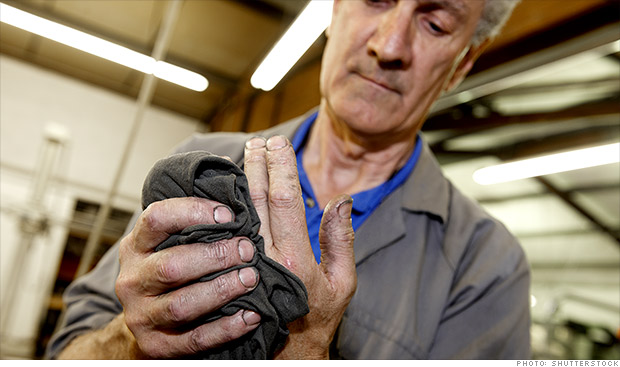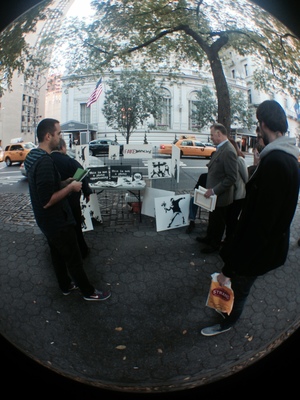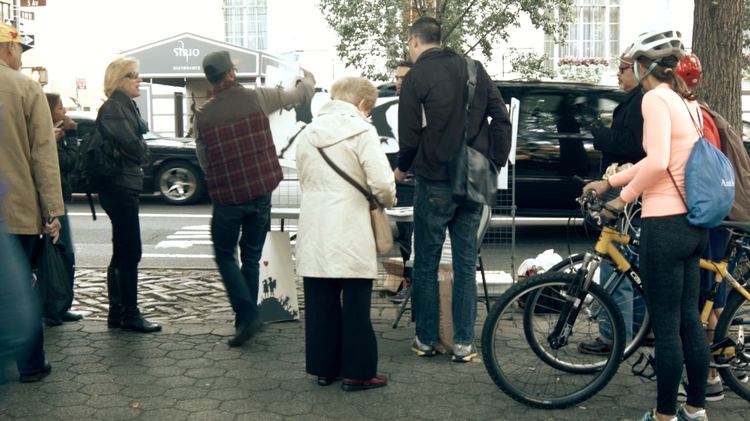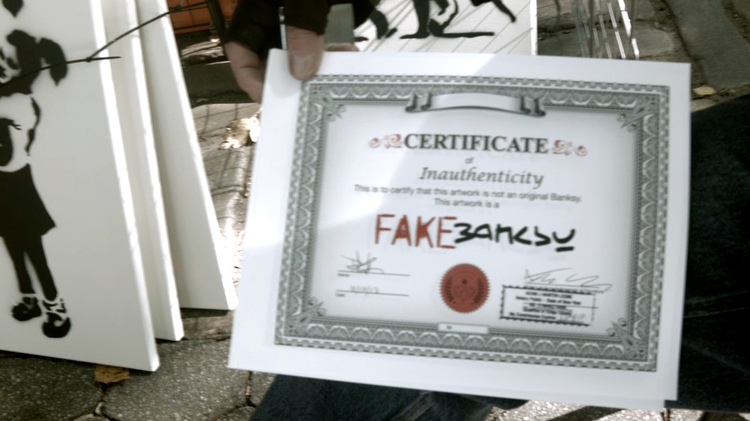 On Sunday night, Jeff Bezos revealed that Amazon is working on drones that can deliver packages up to five pounds, to your house in less than half an hour.
On Sunday night, Jeff Bezos revealed that Amazon is working on drones that can deliver packages up to five pounds, to your house in less than half an hour.Sunday, December 1, 2013
Amazon Promises Half-Hour Shipping By Drone
 On Sunday night, Jeff Bezos revealed that Amazon is working on drones that can deliver packages up to five pounds, to your house in less than half an hour.
On Sunday night, Jeff Bezos revealed that Amazon is working on drones that can deliver packages up to five pounds, to your house in less than half an hour.Saturday, November 23, 2013
If The Cops Pull You Over, These Are Your Rights

When we heard about a New Mexico man's nightmarish traffic stop, we wondered what rights you actually have when you get pulled over.
We talked to Martin Kron, a New York traffic attorney and former traffic court judge, and his son, attorney Daniel Kron, about your rights on the road.
Police can't pull you over without probable cause.
Cops can't just randomly stop you and look for drugs in your car. They need a reason, or "probable cause," like speeding or a broken tail light.
Let's say you are speeding, the police do pull you over, and they do find drugs in your car. But let's say the officer wants to give you a break and forgoes a speeding ticket. Cops don't need to ticket you for speeding to provide probable cause for the stop in court; their notes from the situation would provide enough evidence.
"It's not enough to just not have a ticket as proof. The officer would have had to fail to write it in his narrative," Daniel Kron said.
You don't have to pull over until you can do so safely.
You should still pull over when you can do so safely, Martin Kron said. And if you can't, you should notify the officer with a hand signal and drive the speed limit.
"The sooner, the better though. Don't upset the officer. Sometimes you might end up with three tickets instead of one," he added, implying officers might look for extra infractions if you made them angry.
You have the right to stay in your car.
"It's perfectly legal for you to say in the vehicle, but doing so looks bad to the officer," Martin Kron said.
Officers often ask people to "step out of the car" as a safety precaution — to make sure the driver doesn't have any concealed weapons. But it's probably best to get out of the car to avoid a tense situation.
It's not a good idea, but you can refuse a breathalyzer.
Most states, including New York, have a statute called "implied consent." When you get your driver's license, you agree to a breathalyzer when pulled over. You can technically still refuse a breathalyzer, but in many states you could get your license suspended for six months if you do.
Now, if police suspect you of drug use, the protocol changes. Based on probable cause, the officer can take you back to the station for either a blood test or analysis from a drug recognition expert, according to Martin Kron.
You are required to stop at checkpoints.
Yes, drivers do have to stop at checkpoints. Police departments plan checkpoints ahead of time, but they must have a specific plan, such as stopping every third car (or every car), according to Martin Kron.
Cops can only search your car without a warrant for these 5 reasons.
1) If you consent, police naturally have a right to search your car.
2) "Plain view" also gives an officer the okay to search your car. "If an officer approaches your car and on the passenger seat he notices a baggie of marijuana ... based on regular activities — meaning he doesn't have to search too hard" then the pot is considered to be in plain view, Daniel Kron said.
3) The third reason is "search incident to arrest," according to Daniel Kron. Basically, if an officer arrests you with probable cause, he or she can then search your vehicle.
4) Your car can be searched if an "officer has probable cause to suspect a crime," Daniel Kron said. For example, it's not illegal to have blood on your front seats, to have a black eye, or to have a ripped-up purse in the car. But all those things in conjunction could be suspicious to an officer.
5) Lastly, "exigent circumstances," allow a warrantless search. Before an officer receives a warrant, he can "break every rule if he suspects the evidence is about to be destroyed," Daniel Kron said.
This happens more often in specific locations, like residences, instead of vehicles. For example, if the police want to conduct a drug search and they hear a toilet flush, they can reasonably enter your home, Daniel noted.
You have to let the cops search your car if they have a warrant.
You have to let them search your car if they have a warrant, but some limits apply to the areas they can search.
"If a police officer believes you have a gun in your vehicle, he's not allowed to search in an area too small to hold it," Daniel Kron noted. In that case, the glove box may be fair game but not the cigarette lighter.
Even if police find something incriminating the warrant didn't stipulate — like drugs in the glove box while looking for a gun — the "plain sight" exception applies. They'll still charge you.
Sunday, November 17, 2013
4 Sex Positions Every Man Should Try

It’s simple for men to reach orgasmm but for her to reach the big O? Count the ways. According to the latest research published in the Journal of Sexual Medicine, vaginal and clitoral orgasms are, in fact, separate sensations.
Don’t obsess over the source of her pleasure, though—just try something new. Interest in testing out new positions actually makes a big difference in her pleasure and her arousal, explains Jen Landa, M.D., Chief Medical Officer of BodyLogicMD and author of The Sex Drive Solution for Women.
Whether your goal is to give her a blended orgasm or target her G-spot, focus on vaginal pleasure or hone in on her clitoris, we’ve rounded up four positions that will help you perform like a pro in between the sheets.

The Pretzel
Kneel and straddle her left leg while she’s lying on her left side. From here, she should bend her right leg around the right side of your waist—allowing full access to her vagina. This position is an upgrade from standard missionary because this sets you up for deeper penetration and allows you to slow your roll. “Most women find sex much more pleasurable when it’s not just constant thrusting,” says Landa. So spend some time exploring her body. This setup gives you complete access to her clitoris for manual stimulation. But don’t feel limited to solely hands on fun. Try withdrawing your penis and, while holding the shaft with your left hand, rub the head against her clitoris. Start out soft and slow, then as you increase speed and pressure, reinsert once you’ve brought her to the brink of an orgasm.

The Standing Dragon
Position her on the edge of the bed, posing on all fours. As you stand behind her, have her arch her back so it lifts her butt upward. With your legs outside of hers, use your thighs to squeeze her knees together, which tightens her vagina around your penis. This position is ideal for G-spot stimulation and also gives you a great view of her curves.

The Flatiron a.k.a. Downward Dog
Have her lie face down on the bed with her knees slightly bent and hips slightly raised. For comfort, and to increase the angle of her hips, you can suggest placing a pillow under her lower abs. From here, enter her from behind and keep your weight off of her by propping yourself up with your arms. This position creates a snug fit—which intensifies her pleasure by making you feel larger to her.

The Pole Position
Lie on your back and bend one of your legs, keeping the other outstretched. Have her straddle the raised leg with a thigh on either side and then lower herself onto your member so that her back is facing you. From here, she should hold your knee and use it for support as she rocks up and down. “This position is great, because it’s a lot like the reverse cowgirl, but with a twist,” says Landa. Raising your knee allows her to rub against your thigh—which produces optimal clitoral stimulation, says Landa.
Thursday, November 7, 2013
An Ex-Cop's Guide to Not Getting Arrested

Dale Carson is a defense attorney in Jacksonville, Florida, as well as an alumnus of the Miami-Dade Police Department and the FBI. So he knows a thing or two about how cops determine who to hassle, and what all of us can do to not be one of those people. Carson has distilled his tips into a book titled Arrest-Proof Yourself, now in its second edition. It is a legitimately scary book—369 pages of insight on the many ways police officers profile and harass the people on their beat in an effort to rack up as many arrests as possible.
"Law enforcement officers now are part of the revenue gathering system," Carson tells me in a phone interview. "The ranks of cops are young and competitive, they’re in competition with one another and intra-departmentally. It becomes a game. Policing isn’t about keeping streets safe, it’s about statistical success. The question for them is, Who can put the most people in jail?"
Which would make the question for you and me, how can we stay out of jail? Carson's book does a pretty good job of explaining—in frank language—how to beat a system that's increasingly predatory.
Be Invisible to Police
Carson has four golden rules, the first of which is, "If police can't see you, they can't arrest you." The simplest application of this concept is that if you plan on doing something illegal, you should do it in the privacy of your home. Yes, you can be arrested while at home, but you can't be profiled sitting in your living room, and profiling is what you're trying to avoid.
The rule extends to activities that are perfectly legal. "In 21st century America," he writes, "as long as you're not committing a crime, you should be able to wear the wildest clothes you want, roam the streets when you feel like it, and lean on a light post or hang out at some wild club if it amuses you." "Should" is the key word. In reality, cops love hassling people who stand out, even though it's not illegal to, say, have a Buckeyes bumper sticker that looks like a pot leaf. If you drive a sports car or a lowrider, you're more likely to attract a cop's attention than if you drive, say, a gray Honda Civic. Same goes for clothes, hairstyles, tone and volume of voice. Be boring.
So try to blend in. Beat cops who patrol the same routes day after day are "incredibly attuned to incongruity." But don't be too reactive when you see cops. "Police are visual predators," Carson writes. "Any sudden change in motion, speed, direction or behavior immediately attracts their attention." That means even if you're doing something you think might attract a cop's attention, quickly doing something else will attract even more attention. "Don't alter the pattern," Carson advises. "Keep on keeping on."
Also, if you can help it, don't go out after dark.
What if I can't be invisible to police?
If police want to hassle you, they're going to, even if you're following the above tips as closely as possible. What then? Every interaction with a police officer entails two contests: One for "psychological dominance" and one for "custody of your body." Carson advises giving in on the first contest in order to win the second. Is that belittling? Of course. "Being questioned by police is insulting," Carson writes. "It is, however, less insulting than being arrested. What I'm advising you to do when questioned by police is pocket the insult. This is difficult and emotionally painful."
Make eye contact, but don't smile. "Cops don't like smiles."
Winning the psychological battle requires you to be honest with cops, polite, respectful, and resistant to incitement. "If cops lean into your space and blast you with coffee-and-stale-donut breath, ignore it," Carson writes. Same goes for if they poke you in the chest or use racial slurs. "If you react, you'll get busted." Make eye contact, but don't smile. "Cops don't like smiles." Always tell the truth. "Lying is complicated, telling the truth is simple."
He also says you should be dignified—unless it looks like you're about to lose both the psychological contest and the one for custody of your body. In which case, you should be strategically pitiful.
First off, you should ask for a notice to appear as an alternative to being arrested. You still have to go before a judge, but you can go under your own power without first going to jail. Carson says the least degrading way to get a cop to issue you a notice in lieu of arresting you is to tell them that you're not a hardened criminal and that being arrested (and having your mugshot taken) is going to impact your employment, education and/or family.
And if that doesn't work? It's debasement time. Start with crying. Bawl hard while begging for a notice (the option here is a notice or jail, not notice/jail or getting off scot free). "Don't waste time worrying about what your friends will think," Carson says. "If they're with you, they're getting arrested too." If they're not with you, they won't know.

If crying fails, and you're willing to do whatever it takes to not go to jail, Carson advises you to "foul yourself so that the police will consider setting you free in order not to get their cruiser nasty." Vomit on your clothes. Defecate and urinate in your pants. Then let the officers know what you've done. If they arrest you anyway, you'll get cleaned and reclothed at the jail.
Reasonable things you should never do
If you're driving too fast and see a police car up ahead, don't hit the brakes. "If you suddenly hit the brakes," Carson writes, "cops in front of you will see your front end dip, a tip-off that you were speeding." Don't drive perfectly, or too slow. Don't slouch or put too much heavy stuff in your trunk, causing your car to ride low. If you're a dde, and you want to roll around town with your fellow dudes, be prepared for a stop. "When cops see four young males in a car, they immediately wonder if this is a crew of criminals out to do a job." If you're going to ride four deep, have one member of your car wear a highly visible item of clothing indicating what you do for a living. For instance, if you're all construction workers car-pooling on the way home from a job site, someone in the car should wear a hard hat. Seriously.
Another reasonable thing you should never do? Allow a cop to search your car. There are many loopholes that allow cops to search your car without probable cause or a warrant, but Carson advises you to say no every time. You should still follow all the rules of a traffic stop—keep hands where cops can see them, give them your paperwork, get out of the car if they ask you to—but never let them search. Always, always, always say no (politely).
Friday, October 25, 2013
Woman Kicked Out of Hotel After 9 Years

A woman who had been living at a Wisconsin hotel for nine years checked out this week after she racked up a $28,000 tab and the hotel tried to evict her.
Jana Ganjian, 64, left the Racine Marriott on her own accord, Sheriff Christopher Schmaling told ABC affiliate WISN.
The reclusive woman had tapped out her savings since moving into the Marriott after her life was turned upside down in 2004, WISN reported. Ganjian's attorney had tried to file a motion with a judge earlier this week to remain at the hotel, but the judge didn't get to it on time, prompting the eviction notice to take effect on Thursday.
"It's a cliché, I know," Ganjian told WISN. "But it feels like a nightmare to me that I can't wake from."
It was unclear where Ganjian moved to.
"I don't know where she ended up going, but she left before we had to evict her," Schmaling told WISN. Prior to Ganjian leaving, hotel staff had been working with her to help her find another place to live.
Ganjian was out of work due to a chronic illness and she moved to the hotel because they provided valuable services she could not find anywhere else, WISN reported.
When contacted by ABC News, hotel officials declined to comment on the eviction.
"As a matter of guest privacy we don't discuss details of our guests' stay," said Jeff Flaherty, senior director of corporate relations of Marriott International Inc.
Thursday, October 24, 2013
Mail Carrier Saves Burning House

Most of us don’t anticipate saving a life when we head off to work each morning, but one Detroit mail carrier did just that when he prevented a woman’s house from burning down.
On Tuesday, postal worker Darrian Crutcher, 48, was making the rounds on his usual 10:30 a.m. route, when he noticed smoke billowing from the upstairs window of a home on Stansbury Street. “There was a young girl, around 12 years old, sitting on the front steps crying,” Crutcher tells Yahoo Shine. “She said her mother was inside the house, so I called 911." The dispatcher told Crutcher to make sure everyone was out of the home—and without a thought to his own safety, he walked inside and found the homeowner, Carolyn Patterson. “She was standing in the living room panicking, so I asked if she had a hose,” he says.
The hose was located on the side of the house. Crutcher raced outside to grab it, then hooked it up to the Patterson’s kitchen sink and dragged it upstairs. “I crawled on my hands and knees because the entire second floor was filled with black and gray smoke,” he says. “I had no idea where the fire was and the woman kept yelling, ‘It’s in the middle room!’ But since I had never been inside her home, I didn’t know where to go.”
The fire, which was located in the master bedroom, began when incense, left unattended, rolled off the woman’s dresser and onto the floor. Eventually, Crutcher found the room, stood up, and began spraying. “I couldn’t see, so I had no idea how close I was to the fire, but there was no time to be scared,” he says. Crutcher sprayed until he heard fire engine sirens outside. “The real guys came in and took care of the job, and I went outside to finish my route,” he says.
Once the flames were extinguished, the firefighters from Engine 30 turned their attention on Crutcher, who they hailed as a hero. “They asked me three times if I wanted a job at the fire department,” he says.
Yahoo Shine could not reach Patterson for comment. However, she told Crutcher that he was a blessing. But the mail carrier of nine years rejects his hero status. “I was there at the right time," he says. “I just did what anyone else would have done."
Saving lives seems to be the unofficial job description of postal workers these days. Earlier this month, after noticing that a mailbox on his route was filled for days with packages containing medication, Michael Wheeley, a mail carrier in Graham, North Carolina, checked on the homeowner, whom he found confined to a chair after having a stroke. Wheeley fed him and called 911.
In 2012, a mail carrier in Bucks County, Pennsylvania, stopped a man from abducting two 9-year-olds after seeing the perpetrator grab them by the necks. Because he delivered mail for the suspect, he helped police track him down. Three years ago, while delivering mail, postal worker Keith McVey of Akron, Ohio, threw down his bag and performed CPR on an unconscious man lying on the side of the road. Only two years earlier, McVey saved a girl from drowning in a lake, and years before that, he administered first aid to a suicidal teen who had jumped off a snowy bridge.
Kelly Rowland’s Biological Dad Pleads With Her To See Him


Three years ago, Solange Knowles hinted to Wonderwall that Kelly Rowland was adopted by their family and had “moved in when she was 5.” Three years later, Rowland’s estranged father of 20 years is publicly pleading to reconnect with his daughter.
67 Year old Christopher Lovett recently spoke to Radar Online on the tumultuous relationship he had with Rowland’s mother while Kelly was a child
It wasn’t physical between me and Kelly’s mom, but there were many days and nights when Kelly would be bawling her eyes out, clutching my leg begging me, ‘Please daddy stop shouting at mummy’. That image of her howling, begging me to stop will haunt me forever.
Lovett admitted to being an abusive alcoholic and due to that he eventually left Kelly and her mother, Doris Rowland Garrison when the singer was seven years old. Lovett says he
I just pray she comes back into my life before it’s too late.[...]I couldn’t control [the drinking and verbal abuse that Kelly witnessed]. I hoped I could make it up to her. But I’m still waiting for that day.
Lovett has tried numerous times in the past to get in contact with Kelly, which has not gone unnoticed by the Grammy award winning singer according to an interview she had with UK Cosmo in November 2011:
He reached out to me saying he wanted to see me, but it’s unfortunate he did it so publicly. I want to meet him, and soon, I really do. I forgave him a long time ago. I haven’t seen my dad for almost 20 years. It’s nothing I want a pity party for. He left me and my mom, and I was angry. I wanted to be a daddy’s girl so bad.
Kelly previously stated she planned on seeing her father on Christmas of 2011 “because tomorrow’s not promised to us.” However, the meeting has not happened and in a September 2013 interview with Essence Magazine, Rowland has no idea why she has not yet:
I haven’t [seen my father yet.] I don’t know what’s stopping me because I’ve had opportunities. But it really is time. I probably need to ask my therapist about it.
Kelly Rowland recently released her fourth solo album, Talk A Good Game. While Kelly had that monster multiplatinum selling single “Motivation” with Lil Wayne in 2011, none of her TAGG singles reached Gold and she has not had a Gold selling album since her debut, Simply Deep in 2002.
Many middle-class Americans plan to work until they die

A growing percentage of middle-class Americans say they have saved so little for retirement that they expect to work into their 80s or even until they either get too sick or die, according to a recent survey.
Nearly half of middle-class workers said they are not confident that they will be able to save enough to retire comfortably, according to a Wells Fargo survey of 1,000 workers between the ages of 25 and 75, with household incomes between $25,000 and $100,000.
As a result, 34% said they plan to work until they're at least 80 -- that's up from 25% in 2011 and 30% last year. An even larger percentage, 37%, said they'll never retire and plan to either work until they get too sick or die, the survey found.
Driving these concerns is that many of the respondents said they simply can't afford to pay their monthly bills and save for retirement at the same time.
"For the past three years, the struggle to pay bills is a growing concern and the prospect of saving for retirement looks dim, particularly for those in their prime saving years," Laurie Nordquist, head of Wells Fargo Institutional Retirement and Trust, said in a statement.
The concerns come as many middle-class families are trying to make do with less. The country's median annual household income is down by more than 8% since 2007. And many of the jobs lost during the recent recession have been replaced with lower wage positions.
With minimal savings built up, a third of those surveyed said Social Security will be their primary source of income during retirement. Of those making less than $50,000, nearly half said they will rely mainly on Social Security.
In August, the average Social Security recipient received around $15,000 a year in retirement benefits, according to the Social Security Administration.
Another factor holding back middle-class savers is a fear of investing in the stock market, said Nordquist.
Across workers of all ages, only 24% said they were confident in the stock market as a place to invest for retirement. And slightly more than half said they don't invest in the stocks because they are afraid to lose their savings in the ups and downs of the market.
This is despite the fact that financial planners say that investing in stocks is the best way to grow a nest egg that will be large enough to cover decades of retirement. Over years of savings, short-term losses are overtaken by the long-term gains that years of compounded returns offer.
"There is a striking amount of fear about the stock market among all investors," she said. "The middle class just isn't making the link between being invested and the potential growth of their savings. To top of page
Hooters Waitress Says She Was Fired Because Of Hair Color

A Baltimore woman is filing suit against Hooters, saying she was fired after putting blonde highlights in her hair, according to a Baltimore television station. She's now filed a discrimination suit.
Farryn Johnson says management told her to change it, but she said she couldn't afford to on her already-stretched budget. She was then reportedly fired for 'improper image.'
"I didn't see that it would be a big issue just because there were a lot of other employees working at the restaurant of other races with color in their hair," Johnson told WMAR. "For instance, there were Asian girls with red hair and Caucasian girls with black hair and blond streaks, so I didn't think it would be an issue for the little piece of blond highlight in my hair."
When asked, Hooters said it will not comment on pending litigation.
Wednesday, October 23, 2013
In One Columbian Town, Women Say No Sex Until Their Demands Are Met

Women in the small town of Barbacaos in southwest Colombia have been sleeping on the sofa for the past few days.
They say they've stopped having sex with their significant others in protest of what they say is the terrible condition of the road that connects their small, isolated town to the rest of Colombia, says reporter John Otis in Colombia.
"Colombians like to say you go to the end of the Earth and take a left — that's where this place is located," he said.
And the women say the conditions of that road is so bad that it takes them 12 to 14 hours to get to the nearest hospital. Otis says even pregnant women have died in the back of ambulances, trying to get to a hospital to give birth.
That's why they've gone on a sex strike, dubbed the "crossed legs movement."
This however, is not the first time that women living in Barbacaos have gone on a sex strike. In 2011 they used the same method, demanding the road be fixed. They were promised a new and improved road, but after two years, there was no improvement.
But they haven't given up and once again, they've gone on strike.
Otis says it's not just the residents of Barbacaos who suffer from bad road conditions in Colombia. He says difficult terrain, such as in the Andes mountains, and a guerrilla war that rages on, all make it very difficult to build new roads and maintain old ones.
"If you're going to send a container of Colombian goods to China, it will cost you more to bring it to a Colombian port than to get it from that Colombian port all the way across the other side of the world to China," he says.
This time it seems that members of the "crossed legs movement" are actually getting results.
Otis says he's seen pictures of bulldozers and heavy machinery on the road, starting repairs.
Monday, October 21, 2013
The Best Sex Position If You’re Tired

Lie on your side, putting a pillow under your head for extra support. Your man kneels directly behind your butt, leaning ever-so-slightly over your body. He should push one of his knees between your legs, positioning his body so he can penetrate you. He places one hand on your back to help support himself as he goes for the plunge. The key to your pleasure is keeping your limbs as limp as a noodle.

This side-by-side canoodle creates incredible friction for him because your thighs are so close together. Plus, having your thigh curved at that angle gives him deeper access. The combo of these two will make even the tiniest guy feel like a god! And while he teases your G-spot, he can nuzzle your breasts or reach around and play with your clitoris — covering all the pleasure bases.
Guys Set Up Fake Banksy Stand, Sell Out

On October 13, the infamous street artist Banksy attempted to sell $60 canvases (worth tens-of-thousands of dollars each) to unsuspecting New Yorkers. In seven hours, he had just three customers.
When news of this broke, the story took over New York. In that echo of media hype, we saw an opportunity for a little mischief, and a chance to make a statement about the nature of hype, public personas, and the value of art.
After a lot of hustle, Lance Pilgrim ( @TheElroyJenkins ) and I, with the help of film maker George Gross ( http://vimeo.com/georgegross ) recreated the Banksy stall one week later.
Same price. Same images. Same location. Everything was the same--we even got Lance's father Michael to be the salesman. Everything was identical...except for two things:
- The public consciousness had changed.
- Our work was completely worthless.
We were open about this. Our sign said "Fake Banksy." Mike assured every customer that it was fake. Each canvas even came with a legally notarized "Certificate of Inauthenticity," claiming that what they bought was not an original Banksy.
It didn't matter.
We sold everything in less than an hour. Including the price sign.
Friday, October 18, 2013
No You Can’t Just Go to the Emergency Room—Unless You Want to Go Broke

About three weeks ago I was walking home from the grocery store when a group of teenagers demanded my wallet, cellphone, and—for reasons I can't fully explain—gallon of whole milk. Although I made no effort to resist, I ended up with a laceration on my lip that required stitches, fairly intense swelling on both sides of my head that required X-rays, and a bruised rib. And I was down a gallon of milk and a dozen eggs. It sucked.
On Tuesday, though, I got some good news—a billing statement from George Washington University Hospital, where I got my stitches, CAT scan, painkillers, and a tetanus shot. Thanks to my employer-provided insurance company, Carefirst Blue Cross Blue Shield, I ended up paying about $50. But if I didn't have insurance, like 47 million working-age adults nationally and approximately 23 percent of 18-to-25-year-olds, it would have increased the bill by a factor of more than a hundred. The sutures alone were $1,400, and another $300 to have them taken out four days later. I'm a young journalist at a nonprofit magazine. I do my best to budget responsibly. But I don't have $5,000 of disposable income just lying around. My unfortunate encounter with typically wayward millennials could have left me broke.
I mention this because conservative lawmakers have spent much of the last four years—and the three weeks since the Affordable Care Act's exchanges opened on October 1—arguing that emergency rooms are a suitable replacement for having health insurance. "We do provide care for people who don't have insurance," Mitt Romney explained during his 2012 presidential campaign. "If someone has a heart attack, they don't sit in their apartment and die." During last year's campaign, now-Sen. Ted Cruz (R-Texas) took heat from doctors groups when he argued against all evidence that it would be cheaper for the state to keep sending the 6.1 million Texans who lack health insurance to emergency rooms than it would to expand Medicaid. And in 2011, then-Mississippi Gov. Haley Barbour (R) explained that he was rejecting the Affordable Care Act's Medicaid expansion in the nation's poorest and unhealthiest state because "there's nobody in Mississippi who does not have access to health care." After all, his office explained, there was always the emergency room.
But by the time the uninsured get to the emergency room, the damage has already been done. According to a study from Harvard Medical School, someone dies as a consequence of not having health insurance about once every 12 minutes in the United States, because they aren't able to seek basic primary care treatment that can prevent more serious problems. (About 9,000 Texans will die each year as a result of Gov. Rick Perry's rejection of the Medicaid expansion, according to an analysis by the Institute for Medical Humanities at the University of Texas Medical Branch in Galveston.) But Barbour and his colleagues missed the broader economic point: Someone has to pay for emergency room visits. Emergency care can help literally stop the bleeding—it did in my case. But it's expensive, and it's not a substitute for regular primary care or health insurance.
In recent months, conservative groups like FreedomWorks and the Koch Brothers-backed Generation Opportunity have sought to dissuade young Americans from purchasing health insurance, arguing that millennials are being forced to pay disproportionately high prices for something they're disproportionately less likely to need. But random crime can happen to anyone—and young people are disproportionately unlikely to be able to pay out of pocket.
If you get mugged in Washington, DC, and you're uninsured, you have some help. As the detective assigned to my case helpfully informed me, the District covers up to $25,000 in medical expenses for victims of violent crime. But there are plenty of other ways to mess up your face that don't involve felonies, and plenty of violent crimes that will send your bill sailing far north of $25,000. (Just consider the case of Salon reporter Brian Beutler.) The numbers back this up: A 2012 study from the Commonwealth Fund found that 51 percent of uninsured young adults—the healthiest age group in the United States—had trouble paying medical bills.
So if you're uninsured and can afford a basic plan, you should get insured—because while your odds of going to the emergency room on any given day are statistically low, your odds of being financially ruined if you do are quite high. Otherwise, it just might cost you the arm and a leg you were trying to save.
Thursday, October 17, 2013
Boy's heartbreaking plea to be adopted

A 15-year-old Florida boy who's been in foster care his entire life is so desperate for a family to call his own, he recently took matters into his own hands.
Davion Navar Henry Only gathered his courage and stepped up to the pulpit at St. Mark Missionary Baptist Church in St. Petersberg, Florida, asking, point-blank, if anyone there might want to adopt him, saying to the church full of parishoners, "I know God hasn't given up on me. So I'm not giving up either."
After learning that his biological mother, who gave birth to him while she was in prison, had passed away, he asked his caseworker, Connie Going, to take him to church so he could make his request. She agreed.
Arriving in a donated black suit too large for him, wearing a zip-on tie he wouldn't have known how to tie himself, he followed intently along with the sermon before declaring, "I'll take anyone. Old or young, dad or mom, black, white, purple. I don't care. And I would be really appreciative. The best I could be."
In a piece that ran in the Tampa Bay Times earlier this month, reporter Lane DeGregory recounts that the boy was shy, but he was determined to speak at the church.

His mother had been in jail on petty theft and cocaine charges when he was born. After his 15 years in foster care, Davion looked her up for the first time and found out she had died. Since then, he's been working to manage his temper and pick up the grades he let slump.
He couldn't let nerves and shyness deter him from showing the people in the pews that he could become somebody's son. So he walked to the front of the church, and he let his earnestness speak.
The Tampa Bay Times detailing Davion's plight has gone viral. The piece got 14,000 shares on Facebook just from the paper's page, and thousands more from aggregation in The Daily Mail, ABC News, People Magazine and others. His story has even been shared in Australian media.
If this were a movie, the happy ending would place Davion within a warm household, where he would learn to be loved and continue to ace his way through high school. But whether or not his brave stunt will earn him a home in real life remains to be seen.
Connie Going, the Eckerd adoption specialist in charge of Davion's case, could not be reached for comment, but data from the Administration for Children and Families' Children's Bureau suggests Davion's chances are hard.
An agency report shows black and Hispanic children made up the majority of kids in foster care at the end of the 2012 fiscal year. And out of 400,000 children in foster care last year, only 52,000 were adopted.
The Times reported that two couples asked about Davion at the time his story was published, but none had moved forward with an adoption.
Florida Department of Children and Families spokesperson Terri Durdaller said the agency got around 300 calls about Davion earlier this week. Since then, the number has risen to "several hundred."
"We hope everyone who calls is a potential parent," Durdaller said. "We're hoping to connect him with a forever family, and that this will bring recognition to the foster system in Florida."
Tuesday, October 15, 2013
Americans Are So Broke They're Selling Their Breast Milk And Hair

Hair, breast milk and eggs are doubling as automated teller machines for some cash-strapped Americans such as April Hare.
Out of work for more than two years and facing eviction from her home, Hare recalled Louisa May Alcott’s 19th-century novel and took to her computer.
“I was just trying to find ways to make money, and I remembered Jo from ‘Little Women,’ and she sold her hair,” the 35-year-old from Atlanta said. “I’ve always had lots of hair, but this is the first time I’ve actually had the idea to sell it because I’m in a really tight jam right now.”
The mother of two posted pictures of her 18-inch auburn mane on www.buyandsellhair.com, asking at least $1,000 and receiving responses within hours. Hare, who also considered selling her breast milk, joins others exploring unconventional ways to make ends meet as the four-year-old economic expansion struggles to invigorate the labor market and stimulate incomes.
In all but two quarters since the beginning of 2011, “hair,” “eggs,” or “kidney” have been among the top four autofill results for the Google search query, “I want to sell my...,” according to Nicholas Colas, chief market strategist at New York-based ConvergEx Group, which provides brokerage and trading-related services for institutional investors.
While Americans can legally sell hair, breast milk and eggs, the sale and purchase of a kidney in the U.S. is against the law.
“The fact that people even explore it indicates that there are still a lot of people worried about their financial outlook,” said Colas, who tracks off-the-grid economic indicators. “This is very much unlike every other recovery that we’ve had. It’s going to be a slow-grinding, very frustrating recovery.”
Egg Donors
At Shady Grove Fertility Center, which has offices in Washington, Virginia, Maryland and Pennsylvania, about 13,000 women will apply this year to be an egg donor. That’s roughly a 13 percent increase from 2012, Ali Williams, marketing assistant supervisor at the fertility center, said in a telephone interview.
The clinic’s own survey last year showed that 65 percent of women said there was at least some financial motivation in deciding to donate their eggs. As few as 3 percent become actual donors due to a strict screening process and lengthy time commitment associated with egg donation.
The slow pace of economic recovery, exacerbated by higher taxes and across-the-board federal spending cuts this year, has soured attitudes among U.S. households. Some 54 percent of Americans say their incomes have “hardly recovered at all” from the recession, according to a September survey by the Pew Research Center in Washington.
Labor Sentiment
Sentiment regarding employment opportunities is similarly bleak, with 52 percent saying the job market has barely recovered since the recession, Pew’s survey shows. Payrolls are still down 1.9 million employees from the January 2008 peak, according to Labor Department data.
Such figures help explain why some Americans are seeking unorthodox ways to supplement their incomes. Hare, who has a 4-month-old son and 7-year-old daughter, researched selling her breast milk online after seeing she could make as much as $5 an ounce.
“These are tough times,” said Hare, who was last employed as a showroom sales manager at a wholesale trade center. “The rich are getting richer and everybody else is losing their jobs and their homes. It’s just terrible.”
Household Income
Median household income, which includes wages and investments, has fallen every year for the past five after adjusting for inflation, according to data from the Commerce Department, with Americans earning less than they did in 1996.
Gains in worker pay have lagged behind the previous recovery. Wages and salaries, unadjusted for changes in prices, have climbed at a 3.2 percent annualized rate since the economy emerged from the recession in June 2009, trailing the 4.5 percent pace in the four years after the 2001 slump.
“If you’ve been unemployed for years, if you’re on food stamps and you’ve had trouble getting by, I can totally see you being very economically desperate,” Colas said. “I don’t think a lot of people sell their kidneys. I do think a lot of people in desperation do that search to say, ‘If worse comes to worst what could I do?’”
While the sale of kidneys is limited to the black market, the organ could fetch $15,200 if legal monetary incentives for donations were introduced, according to 2007 research by University of Chicago economics professor Gary Becker and Julio Elias, then an economics professor at State University of New York at Buffalo.
Unemployment Benefits
Such a decision may be influenced by a labor market that’s struggling to improve and unemployment benefits that are running out. The jobless rate has been above 7 percent since the end of 2008. The share of unemployed Americans out of work for 27 weeks or longer was 38 percent in August, more than double what it was before the end of the last expansion, according to Labor Department figures.
“Clearly that would be creating some pressure for people who haven’t been able to work,” Becker said. “They’re getting unemployment compensation that was less than they had in their last job, or their unemployment compensation may have run out and they’re on welfare.”
At Shady Grove Fertility Center, egg donors receive compensation at almost every step of the process, earning $7,000 by the time they finish their first donation cycle. Women can receive $7,500 for a second donation and $8,000 for each additional cycle up to a total of six, incurring no out-of-pocket costs along the way.
Financial Reasons
Still, 73 percent of women said altruism influenced their choice more than financial reasons, the survey showed.
“It is more than cutting your hair and even donating blood,” Shady Grove’s Williams said. “The process can take a few months. So if you don’t have that altruistic motivation, if you’re just doing it for money, you’re probably not going to get through the process.”
The average donor is about 27 years old, and 78 percent have a college degree or are pursuing one, Williams said. More than half of donor applications come through an online resource.
The Internet is probably responsible for much of the increased interest in cashing in on body parts, Becker said. Online search engines and exchanges make communications between “buyers and sellers of things like organs or hair much easier,” he said.
Interest Rates
Bridie MacDonald in Farmington Hills, Michigan, lost her job in mortgage marketing on Sept. 27, a casualty of interest rates that have risen almost 1 percentage point since the start of May, when the Federal Reserve began signaling it could scale back its unprecedented stimulus program.
With naturally red hair, the 25 year-old posted an online ad on Oct. 1 looking to sell up to 18 inches of her locks for $1,500. Since then, she’s received more than 100 responses.
“I’ve been growing my hair out for maybe a little over two years, and I just decided now was the time since I lost my job,” MacDonald said. “It doesn’t cost anything to grow your hair out and sell it for money. It’s basically profit with very little work. Anything you can do, I’m sure people are willing to do it.”
Monday, October 14, 2013
Motorcyclist Gets Hijacked At Gunpoint And Then Hijacker Is Shot In One Uncut Video

Everything can change in a matter of seconds.
The following helmet-cam footage captures that universal truth with raw intensity. In it, a motorcyclist is hijacked at gunpoint at a stop light. Mere moments later, an officer shoots the robber twice at a close range.
The whole episode lasts a mere 20 seconds.
The first-perspective makes it even more unnerving. It’s a jarring look at the random chaos of life, a fleeting glimpse of just how quickly our sense of security can be shattered.
As with dash cams in Russia, helmet-mounted cameras are popular with motorcyclists as a means of insurance, capturing interactions on the road from the driver’s point of view. The rest of the videos by YouTube user Anderson Mangai, which commenters believe to be shot in Brazil—an assumption backed up by the Portuguese used in the title and description—are from his motorcycle as well.
It's worth noting that the officer acted in apparent self-defense. The following screengrab, as mentioned on Reddit but reproduced below, shows the robber drawing his weapon at the 59-second mark.
What I find even equally unsettling are the six minutes of video that follow. People are just standing around while traffic buzzes by in the background. It’s almost as if nothing even happened.
(Warning: The video is graphic and NSFW.)
The Army’s $5 billion New Uniform Already Being Replaced

In 2004, the Army decided to scrap the two traditional camouflage uniforms that had long been used by the military—one meant for woodland environments, another for the desert—and claimed to have come up with a universal pattern that could be worn anywhere and blend in with any environment. The $5 billion dollar experiment with the universal pattern is over as the Army is phasing out the uniform after less than a decade of use. But many soldiers and observers are wondering why it took this long and cost this much to replace an item that performed poorly from the start during a period when the money could have been spent on other critical needs, like potentially life saving improvements to military vehicles and body armor.
Less than a decade after the so-called Universal Camouflage Pattern, or UCP, was introduced the Army is back to the drawing board, set to announce a new camouflage pattern and standard uniform to be worn by the more than million members of the active duty and reserve forces.
Evidence of the UCPs inadequacy as a combat uniform is easy to find—just look at pictures of soldiers currently serving in Afghanistan, they’re not wearing the UCP, which was deemed unsuitable for operations there, but a different uniform known as the MultiCam. In 2009, Congress responded to soldiers’ “concerns about the current combat uniform which they indicated provides ineffective camouflage given the environment in Afghanistan,” by passing a bill in the appropriations act requiring that the DOD “take immediate action to provide combat uniforms to personnel deployed to Afghanistan with a camouflage pattern that is suited to the environment of Afghanistan.” The result was the MultiCam. But that uniform, while it is currently worn in Afghanistan, was not a replacement but an interim substitution for the UCP, which is still the Army’s official uniform and the one worn by all soldiers not overseas.
Only 5 years after it was introduced the UCP’s failures had already become glaring enough to compel congressional intervention but despite the moratorium on its use in Afghanistan, it will have taken another 5 years for the Army to field its replacement.
Eventually, after mounting criticism and reports of the uniforms problems, the Army started looking for something better. This time, instead of hoping for a universal, one-size-fits-all design, an Army source who wished to remain unnamed explained that the Army solicited designs from companies for patterns with three variations, one for the desert, another for woodlands and jungles and a third, traditional semi-wooded pattern similar to the one currently used by soldiers in Afghanistan. After several rounds of testing, four patterns with three variations for each, from companies in New York, Virginia and Alaska were submitted to the Army to choose a winner.
Critics say this has been a huge waste of money.
Last year, the Government Accountability Office, a federal watchdog agency, issued a report taking the Army to task for spending $5 billion on UCP-covered uniforms and field equipment, only to spend an estimated $4 billion replacing them with whatever design it picks next. The Natick Army Soldier Systems Center, which does research and development on things like food, clothing, shelter for the military, conducted two studies on the Universal Camouflage Pattern, once in 2006 and again in 2009, both times finding that the UCP’s performance came up short when compared to other, more popular camouflages, like the Marine Corps desert pattern or the MultiCam. Natick scientists also went on record alleging that the Army had already selected the UCP before testing on it was completed and a full evaluation could be made of its performance compared to other designs.
Representatives from Natick did not return requests for comment on this story and the Government Accountability Office is currently closed due to the government shutdown.
But these reports only reinforce the views expressed by, arguably the most important critics of the Army’s near-decade long quest for the perfect uniform: the soldiers who have to wear them.
During former Army Officer Matt Gallagher’s 15-month deployment to Iraq from 2007-2009, he became well acquainted with the shortfalls of the universal camouflage pattern. In an attempt to blend in with all kinds of environments, the pattern instead wound up sticking out everywhere, its grey, gravel design that only a help to soldiers hoping to blend in with a parking lot. Gallagher said his soldiers would call the uniform pajamas, “both a testament to its comfort and its inability to look right on anyone, no matter their build.” But Gallagher found that the biggest concern with the UCP in Iraq was shoddy velcro.
“On a night raid, if it gets caught on a wire or something, it would make a crunchy sound that might alert insurgents to a soldier’s location,” he said. “That wouldn’t happen with just cloth.”
Army Sergeant Matt Pelak laughs at the mention of the universal camouflage pattern.
“It is one of the things that drives me craziest about the army I have to admit,” he told The Daily Beast. We started rolling it out in ‘05 and everyone was baffled by it.”
While Pelak admits there were some upsides to the design, such as easy-to-access pockets, his complaints outweighed the positives.
“Even currently, in my unit that I’m in now, we wear the normal uniform, the UCP when we’re back on base, but when we go in the field we wear MultiCam,” he said. “We have to carry two uniforms around, one that functions properly and one that’s merely administrative.”
Pelak points out this is hardly the first time the Army has spent billions of dollars on insufficient equipment just to spend more money to replace it, recalling the $20 billion Future Combat Systems program that launched in 2003 to develop a fleet of universally used lightweight armored vehicles and was canceled in 2009, ultimately considered a failure.
“It’s as ridiculous as buying 20 million humvees to go to war in that weren’t armored and then when the war started they had to build all new humvees that were bullet proof,” he said. “It’s that absurd.”
Pelak is not hesitant to admit that, within the ranks, the seemingly unnecessary and wasteful uniform program smells like “a giant conspiracy.”
“People in the military associate certain projects with nepotism, a Good Old Boy network,” Pelak said. “Maybe someone’s brother owns the company that designs the uniforms, or he’s on the Defense Appropriations Committee. No one knows exactly, but there are a lot of theories that all involve some sort of cronyism or backhand deal.”
If it were up to Gallagher, the billions that have been spent on two rounds of designing, testing, issuing new uniforms would instead go to finishing a water treatment plant that was started when he was in Iraq. “The local citizens need that treatment plant far more than we need a new batch of uniforms,” he said.
Neither Gallagher nor Pelak are sure that the ambitious goal of designing a universally functional pattern is realistic, but they both agree that the MultiCam design or the Desert Camouflage Uniform, are the best options they’ve been given so far.
For his part, Pelak would like to see less money spent designing uniforms and more money spent on better quality field equipment, such as more durable boots and lighter backpacks.
“It took 12 years to develop body armor for women,” he said. ‘I thought that was a joke when they announced body armor for women at the end of both wars and that’s absolutely needed. Not a lower budget version of a backpack you can’t even jump out of an airplane with.”
Unfortunately, Gallagher said, “What’s best for soldiers in the field is usually not a primary decision-maker. This is all about defense industry contracts, and just one example of the labyrinth that is that messy, nepotistic world.”
The Army, however, downplays the conspiracy theory. “It’s not like someone pulled the UCP out of their posterior and said let’s use it,” said the unnamed Army source. “They actually did a test and it performed pretty well, but as you can imagine, anything that’s universal doesn’t work that well in all situations.”
The Army source’s claim that the UCP tested well is contradicted by two different studies conducted by Natick showing that the MultiCam outperformed the UCP in various environments and the statements made by Natick scientists accusing the military of selecting the UCP before the full testing on it was complete.
The same source also insists the fuss over wasted money is overblown. “It’s like if you spent $5 billion on Hanes t-shirts and then 5 years later decided you should have bought Under Armor,” he said. “It’s not like you wasted money on those shirts because you got use out of them. We used those uniforms for their lifespan.”
The criticism made by many soldiers and Army watchdogs is that clothing that costs $5 billion dollars and is made for Soldiers going into combat ought to be of higher quality and last longer than a Hanes t-shirt. Despite the Army’s initial claims about fielding a universal uniform of the future, the UCPs nine-year lifespan is less than half the length of its considerably less expensive predecessor, the BDU uniform, which lasted for two decades. What’s more, the UCP wasn’t even worn by soldiers in Afghanistan during the last four years of its duration.
Over the past decade the Army has utilized four different uniforms, with each representing a considerable expenditure and investment of time and resources that could have been applied to other commonly cited needs, like upgrades to field equipment and improvements to tactical vehicles.
Whether the current quest for the consummate camouflage will prove time and money well spent or yet another waste remains to be seen. In the meantime, Pelak said, “We’re stuck with a uniform we can’t wear in the field.”
Subscribe to:
Posts (Atom)




